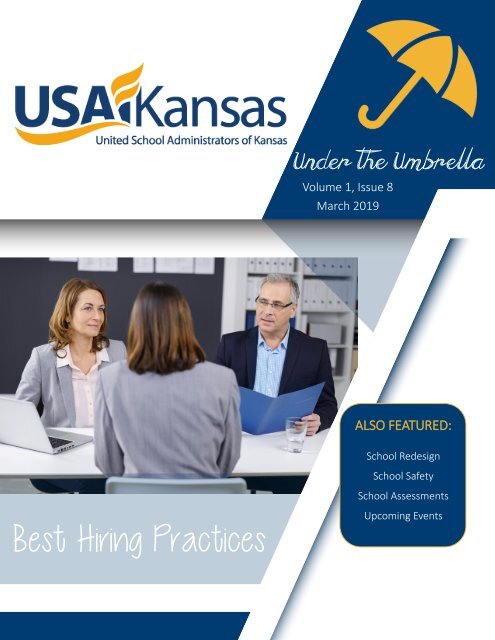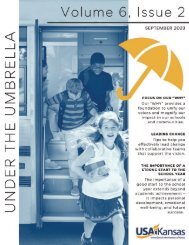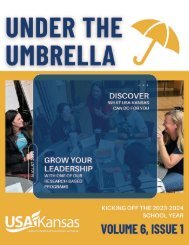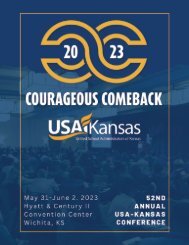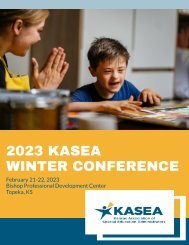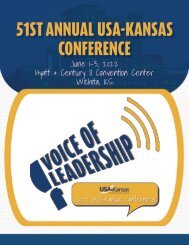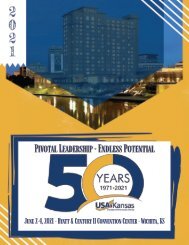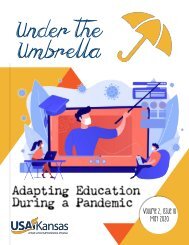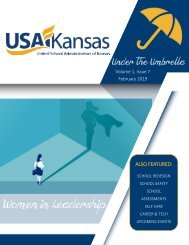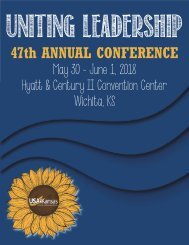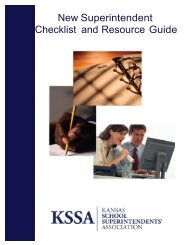Under the Umbrella, Volume 1, Issue 8
You also want an ePaper? Increase the reach of your titles
YUMPU automatically turns print PDFs into web optimized ePapers that Google loves.
<strong>Under</strong> <strong>the</strong> <strong>Umbrella</strong><br />
<strong>Volume</strong> 1, <strong>Issue</strong> 8<br />
March 2019<br />
ALSO FEATURED:<br />
School Redesign<br />
School Safety<br />
School Assessments<br />
Best Hiring Practices<br />
Upcoming Events
CONTENTS <strong>Volume</strong> 1, <strong>Issue</strong> 8<br />
2 Upcoming USA-Kansas Conference, G.A. Buie<br />
BEST HIRING PRACTICES<br />
3 The Business of Best Practices in K-12 Hiring, Eric Hansen<br />
4 When Hiring Teachers, District Leaders Prioritize ‘Cultural Fit.’<br />
That Can Be a Problem, Madeline Will<br />
4 Why Should Leaders Start Being Coached?, Peter DeWitt<br />
6-7 Principals and AP’s: You’re Rich Already Without Mega<br />
Billions, Mark Wilson<br />
8 Using Resumes to Set Your Interviews, Jerry Henn<br />
10-11 What’s <strong>the</strong> Blueprint?, Joe Sample<br />
11-13 4 Steps Every School Leader Needs to Take This Year, Dr. Bill<br />
Ziegler<br />
14 2020 Kansas Teacher of <strong>the</strong> Year Nomination Packet<br />
Available, KSDE<br />
14 Whitney Morgan Named 2019 Kansas Teacher of <strong>the</strong> Year,<br />
KSN News<br />
SCHOOL REDESIGN<br />
16-17 You Are On <strong>the</strong> Way in 2019 Toward Your Goal, Dr. John<br />
Vandewalle<br />
17 Redesign From Kingman-Norwich Schools, Bob Diepenbrock<br />
18-20 It Is a ‘Perfect Storm’, Dan Whisler<br />
SCHOOL SAFETY<br />
22 More of <strong>the</strong> Same a Year After <strong>the</strong> Parkland Shooting, Doug<br />
Parisi<br />
SCHOOL ASSESSMENTS<br />
24 A Better Way to Assess Oral Reading Fluency eBook, Kristie<br />
Werner<br />
25 Upcoming Events<br />
NETWORK & STAY CONECTED<br />
@USAKansas<br />
Facebook.com/USAKansas<br />
2018-2019 USA-Kansas<br />
Board of Directors<br />
Sean Cochran—President, KASEA<br />
Ryan Jilka—President Elect, KAMSA<br />
Pete Bastian—Past-President, KAESP<br />
Mike Berblinger—Director, KSSA<br />
Cory Gibson—Director, KSSA<br />
Eric Hensen—Director, KASBO<br />
Volora Hanzlicek—Director, KASCD<br />
Ron Barry—Director, KASSP<br />
Justin Henry—Director, KSSA<br />
Christie Meyer—Director, KASCD<br />
Bert Moore—Director, KASEA<br />
Suzan Patton—Director, KSSA<br />
Dennis Peerenboom—Director, KASPA<br />
Jake Potter—Director, KanSPRA<br />
P.J. Reilly—Director, KCCTEA<br />
Donna Schmidt—Director, KASSP<br />
Glen Suppes—Director, KSSA<br />
Patrick Schroeder—Director, KAESP<br />
Donna Zerr—Director, KASSP<br />
G.A. Buie—Executive Director<br />
Jerry Henn—Assistant Executive Director
UPCOMING USA-KANSAS CONFERENCE<br />
G.A. Buie, Executive Director, USA-Kansas<br />
As <strong>the</strong> familiar melody states,<br />
“Oh <strong>the</strong> wea<strong>the</strong>r outside is<br />
frightful and <strong>the</strong> snow is so<br />
delightful.” Well, it might be<br />
delightful in December and<br />
January, but as we move into<br />
March many of you may think<br />
it’s just frustrating. So, let’s move forward and<br />
think about warmer wea<strong>the</strong>r and happier days.<br />
Your 2019 USA-Kansas Annual Conference is just<br />
around <strong>the</strong> corner and we believe we have<br />
planned relevant learning opportunities mixed<br />
with just <strong>the</strong> right touch of relaxation. Beginning<br />
May 29, Alan November will start us off as he<br />
discusses instructional technology. This will be<br />
followed by a vendor session with over 90<br />
companies in attendance, heavy hors d’oeuvres,<br />
drinks, and a chance to win a TV, Royals tickets (in<br />
<strong>the</strong> All-Star Suite), gift cards, and a host of o<strong>the</strong>r<br />
prizes all located at <strong>the</strong> USA-Kansas Got APP<br />
booth. And, of course, golf will tee off around 7:30<br />
a.m.<br />
On May 30, we have scheduled over 60 breakout<br />
sessions to run throughout <strong>the</strong> day. Our board<br />
feels <strong>the</strong>y have found multiple learning<br />
opportunities for any administrator. We will be<br />
introducing our new Innovative Classroom<br />
Learning space located between <strong>the</strong> upper lobby<br />
of <strong>the</strong> Hyatt and <strong>the</strong> Century II. We plan to finish<br />
Thursday at <strong>the</strong> conference with our annual<br />
President’s Reception hosted by Jostens, and later<br />
in <strong>the</strong> evening we are excited to host Lifetouch’s<br />
reception featuring Fun Pianos! Dueling Pianos<br />
2<br />
Show. A full list of breakouts will be located on our<br />
website soon.<br />
As we close out May on <strong>the</strong> 31st and finish <strong>the</strong><br />
2019 conference, we are excited to host<br />
Commissioner Randy Watson and Kansas City’s<br />
own stress reliever and humorist Mr. Kent Rader.<br />
Kent shares how he survived five years as a public<br />
accountant and 12 years as a hospital C.F.O. and<br />
C.E.O. Kent carries <strong>the</strong> title as <strong>the</strong> “Worlds<br />
Cleanest Comedian.” He has been featured on<br />
NPR, Sirius Satellite radio, and is a winner of <strong>the</strong><br />
Branson Comedy Festival. Okay, where else in<br />
Kansas can you find top notch professional<br />
development, relationship building opportunities,<br />
great food and stress relief, and never have to<br />
leave <strong>the</strong> hotel? The USA-Kansas – Uniting<br />
Leadership Conference!<br />
Please consider joining your peers in Wichita May<br />
29-31.<br />
Click Here for Conference Info!
BEST HIRING PRACTICES<br />
THE BUSINESS OF BEST PRACTICES IN K-12<br />
HIRING<br />
Eric Hansen, Business Director for Bonner Springs/Edwardsville USD 204, USA-Kansas Board of<br />
Directors<br />
Each year, School<br />
Administrators and Human<br />
Resources staff wade through a<br />
web of applicant tracking and<br />
hiring processes that can, at<br />
times, seem cumbersome;<br />
especially in cases where<br />
recruitment and onboarding teams are working with<br />
minimal staff and tight budgets. Effectively blending<br />
strategy and technology into your district’s hiring<br />
plan can help you and your teams identify <strong>the</strong> best<br />
candidates for your district while at <strong>the</strong> same time,<br />
reducing administrative burden.<br />
Workflows<br />
Review your district’s workflow regularly. This will<br />
ensure your applicants and internal stakeholders are<br />
receiving notifications and updates as milestones<br />
occur periodically throughout <strong>the</strong> hiring process.<br />
Keep in mind, this segment of <strong>the</strong> process can also<br />
serve as a candidate’s first experience with your<br />
district. A dysfunctional and fragmented workflow<br />
can lead to poor first impressions which can<br />
eventually reduce interest on <strong>the</strong> part of potential<br />
prospects. Analyze <strong>the</strong> effectiveness of your hiring<br />
software. At a minimum, your HR Director should be<br />
able to determine how customizable your system is<br />
and whe<strong>the</strong>r or not you are being forced to<br />
compromise best practices due to incompatible<br />
technology.<br />
Timeline<br />
It is no secret that as a district’s hiring process drags<br />
into <strong>the</strong> summer months, a pool of less qualified<br />
applicants will materialize while more qualified<br />
candidates accept job offers elsewhere. A poorly<br />
designed hiring process can also lead to desperately<br />
trying to fill positions at <strong>the</strong> last minute. These<br />
ingredients will undoubtedly leave your district with a<br />
subpar staff which can dovetail into lower<br />
achievement, high turnover, and poor morale.<br />
Unless you are offering contracts by <strong>the</strong> end of <strong>the</strong><br />
school year, <strong>the</strong>re's a good chance you are losing out<br />
on some of your better candidates.<br />
Onboarding<br />
Keep in mind that <strong>the</strong> onboarding process presents<br />
new employees with ano<strong>the</strong>r “first impression” of<br />
you and your district. Redundant paperwork,<br />
processing delays, and a lack of clear and timely<br />
communication can set <strong>the</strong> stage for frustration<br />
before your new teachers step foot into <strong>the</strong>ir<br />
classrooms. Where do teachers have to go to fill out<br />
<strong>the</strong>ir paperwork? How much paperwork is <strong>the</strong>re?<br />
Are <strong>the</strong>re any unnecessary steps in <strong>the</strong> process?<br />
When reviewing your hiring process, don’t neglect<br />
<strong>the</strong> final stage – <strong>the</strong> transition from “candidate” to<br />
“team member”.<br />
The most effective<br />
hiring and<br />
onboarding<br />
technology<br />
programs should<br />
offer a smooth<br />
transition from<br />
“applicant record” to “employee record”. This will<br />
minimize redundant steps and save HR staff hours of<br />
manual data entry while at <strong>the</strong> same time, facilitating<br />
a positive experience for new hires. Hiring and<br />
retaining quality staff for your schools can be time<br />
consuming and expensive, but <strong>the</strong> long-term savings<br />
of an effective and efficient hiring process can be<br />
significant for district leaders.<br />
3
WHEN HIRING TEACHERS,<br />
DISTRICT LEADERS PRIORITIZE<br />
‘CULTURAL FIT.’ THAT CAN BE<br />
A PROBLEM<br />
WHY SHOULD LEADERS START<br />
BEING COACHED?<br />
Peter DeWitt, Education Week<br />
Madeline Will, Education Week<br />
When hiring teachers,<br />
district leaders<br />
prioritize "cultural fit"<br />
above all else,<br />
including training and<br />
experience. But most<br />
are unable to measure what exactly that means.<br />
That's according to a new study from <strong>the</strong> Frontline<br />
Research and Learning Institute, which asked 594<br />
school and district hiring managers from across <strong>the</strong><br />
United States to describe <strong>the</strong>ir hiring preferences.<br />
Slightly more than half of <strong>the</strong> respondents were<br />
involved in recruiting and hiring decisions at <strong>the</strong><br />
school level (like principals) and <strong>the</strong> rest served at<br />
<strong>the</strong> district level, mostly in human resources. Most<br />
of <strong>the</strong> respondents were from urban and suburban<br />
school districts. (The institute is a division of<br />
Frontline Education, which is a K-12 software<br />
company.)<br />
Researchers from <strong>the</strong> institute have previously<br />
found that district hiring managers prefer candidates<br />
who are recommended to <strong>the</strong>m via word of mouth,<br />
even though <strong>the</strong> majority of candidates come from<br />
sources like commercial job boards. The researchers<br />
were concerned that this could hinder teacher<br />
diversity and increase teacher turnover, if <strong>the</strong><br />
personal connection is prioritized over fit.<br />
Click Here to view full story.<br />
4<br />
Many leaders agree that coaching is an important way<br />
to grow.<br />
Let's rewrite that…<br />
Many leaders believe instructional coaching is a great<br />
way for <strong>the</strong>ir teachers to grow. They understand how<br />
instructional coaches will work on a co-constructed<br />
goal with teachers, and can easily see how <strong>the</strong><br />
relationship is beneficial because those leaders often<br />
see <strong>the</strong> impact of instructional coaching when <strong>the</strong>y<br />
walk into classrooms to do <strong>the</strong>ir "learning walks,"<br />
"walk throughs," or..."rigor walks."<br />
What's interesting, is that when <strong>the</strong> coaching<br />
relationship is offered up to leaders, <strong>the</strong>ir openness to<br />
working with a coach isn't always immediately<br />
evident. And it's often for <strong>the</strong> same reasons that<br />
teachers aren't always open to being coached. Some<br />
of those reasons may be:<br />
• Insecurity sets in. They suddenly become insecure<br />
that <strong>the</strong>y're doing something wrong or are no<br />
longer good enough for <strong>the</strong> position<br />
• They don't want o<strong>the</strong>rs to know <strong>the</strong>y are being<br />
coached because of <strong>the</strong> perception that may<br />
create...are <strong>the</strong>y now seen as a bad leader?<br />
• They don't have time to be coached. They have<br />
much more important things to do.<br />
• What could <strong>the</strong> coach offer <strong>the</strong>m, that <strong>the</strong>y as <strong>the</strong><br />
leader, don't already know?<br />
Click Here to view full story.
PRINCIPALS AND AP’S: YOU’RE RICH ALREADY<br />
WITHOUT MEGA BILLIONS<br />
Mark Wilson, The Principal Matters!<br />
Our ice-breaker question for professional learning<br />
over <strong>the</strong> past week has been a fun one: If you win <strong>the</strong><br />
$1.6 Billion lottery prize, what will you do?<br />
Some of my favorite answers heard across my travels<br />
include: Start an early-childhood program for our<br />
county; give a check for $15,000 to all of <strong>the</strong> teachers<br />
at my school; buy a villa in Italy; get my hair dyed; go<br />
off <strong>the</strong> grid.<br />
Have you had fun thinking about what you might do<br />
with nearly-unlimited financial resources? A story<br />
about this topic on <strong>the</strong> radio captured my<br />
attention. According to <strong>the</strong> psychologist who was<br />
being interviewed, most of <strong>the</strong> people who were<br />
buying tickets knew <strong>the</strong>y were extremely unlikely to<br />
win (same odds as being struck by lightning WHILE<br />
being attacked by a bear); never<strong>the</strong>less, millions of<br />
people purchased tickets, in great part for <strong>the</strong><br />
experience of exploring limitless possibilities.<br />
The endorphins that are released as we think about<br />
such things are feelings that we enjoy and are, for<br />
most people, worth <strong>the</strong> two dollars to enter.<br />
The radio story concluded with <strong>the</strong> idea that<br />
mammoth jackpots (I think I'd be happy with <strong>the</strong> base<br />
amount?) serve a positive effect by creating positive,<br />
happy feelings as a result of our dive into our dreams,<br />
hopes, and wishes if money were not a<br />
consideration.<br />
Here's <strong>the</strong> thing you should consider as a school<br />
leader: you don't HAVE to win (or even play) <strong>the</strong><br />
6<br />
Lottery to have <strong>the</strong> euphoria of amazing possibilities;<br />
<strong>the</strong>y are around you every day!<br />
Two dollars is a cheap<br />
price to pay for <strong>the</strong><br />
chance to think about<br />
"what if...?" But, you're<br />
a school leader: you<br />
don't need a ticket to<br />
Awesomeness<br />
surrounds you... if<br />
you let it.<br />
explore infinite possibilities. Awesomeness<br />
surrounds you... if you let it.<br />
One of <strong>the</strong> greatest<br />
parts of your job as<br />
school leader is <strong>the</strong><br />
freedom to<br />
imagine. You can<br />
ask "what if" to<br />
things you see<br />
every day. What if you complimented that student<br />
on her work? What if you give <strong>the</strong> feedback your<br />
teacher needs to make <strong>the</strong> changes he needs to<br />
make to reach his students? What if you lead a<br />
team of students and teachers in strategizing how<br />
to get more students involved in school activities?<br />
As powerful as it is for you to explore possibilities,<br />
it's even greater still for you to lead a school whose<br />
culture is about 'what if?' In that culture, a teacher<br />
asks, "what if we do more to meet <strong>the</strong> needs of this<br />
group of students who are struggling?" Ano<strong>the</strong>r<br />
teacher asks, "what if we connect virtually with a<br />
school on ano<strong>the</strong>r continent?" A student asks,<br />
"what if we had a skateboard club?"<br />
There are amazing ideas in <strong>the</strong> heads of students,<br />
teachers, staff, and parents at every school.
Unfortunately, all schools don't have <strong>the</strong> same<br />
attitude towards possibilities. Schools are too often<br />
seen as places where <strong>the</strong> answer is usually<br />
'no.' Schools where possibilities are highly valued<br />
are places of inspiration where ideas come from all<br />
directions and students grow accustomed to<br />
dreaming, imagining, and thinking creatively. And<br />
<strong>the</strong>n, <strong>the</strong>y take those attitudes and skills with <strong>the</strong>m<br />
with <strong>the</strong>y leave, where <strong>the</strong>y are as valuable as nearly<br />
anything else <strong>the</strong>y take with <strong>the</strong>m from <strong>the</strong>ir<br />
schooling days.<br />
Schools that are too busy to dream, too busy to<br />
think about 'what if', too busy to create and imagine<br />
are schools that are skipping an important part of<br />
<strong>the</strong> learning experience. It's <strong>the</strong> possibilities that<br />
fuel <strong>the</strong> passion for learning and lead to better ways,<br />
better days, and better school experiences.<br />
Don't squander <strong>the</strong> opportunities you have every<br />
day as someone privileged enough to lead a<br />
school. Challenge o<strong>the</strong>rs to do <strong>the</strong>ir best; encourage<br />
students to stretch <strong>the</strong>ir learning, to compete at <strong>the</strong><br />
highest levels in <strong>the</strong>ir areas of passion. Push your<br />
best teachers in <strong>the</strong> building to be <strong>the</strong> best teachers<br />
in <strong>the</strong> county, <strong>the</strong> state, and <strong>the</strong> world. Raise <strong>the</strong>ir<br />
gaze and let <strong>the</strong>m amaze. Show o<strong>the</strong>rs what<br />
greatness lies inside <strong>the</strong>m.<br />
Remember before <strong>the</strong>y drew <strong>the</strong> winning<br />
numbers? You had a ticket and despite <strong>the</strong> odds, for<br />
a moment, you dared to dream like anything might<br />
be possible. With that same spirit, look at your<br />
school, your teachers, your students. Look at<br />
yourself. See <strong>the</strong> endless possibilities in you and<br />
around you and get busy making those ideas come<br />
true.<br />
COMMUNICATION<br />
CORNER<br />
Using a Team Approach to Enhance Your<br />
Hiring Process<br />
Submitted by Jake Potter, Director of Public Relations,<br />
Leavenworth USD 453<br />
Even before a candidate has submitted an application for<br />
an employment vacancy, <strong>the</strong>y are likely searching <strong>the</strong><br />
internet for news stories, visiting your web site, reaching<br />
out to current staff members, and collecting as much<br />
information as possible to determine whe<strong>the</strong>r or not your<br />
district is a right fit for <strong>the</strong>m.<br />
It is important to have relevant information to your hiring<br />
process, quick and easy to find, available on a variety of<br />
messaging platforms. You might consider dedicating a<br />
standalone ‘tab’ to Human Resources that is searchable<br />
from <strong>the</strong> main page of your organization’s web presence.<br />
This page can be updated to reflect current openings,<br />
starting salary and benefits, upcoming recruiting dates,<br />
and frequently asked questions. For districts that also<br />
maintain a robust social media presence, “Now Hiring” job<br />
postings can be shared via Facebook, Twitter, and LinkedIn<br />
to help widen your search for qualified applicants.<br />
Efforts to retain and celebrate your current staff can also<br />
have an indirect, yet positive, effect on increasing <strong>the</strong><br />
number and quality of your future candidates. Providing a<br />
welcoming and supportive environment to your newest<br />
team members will leave <strong>the</strong>m with a good first<br />
impression that <strong>the</strong>y are likely to share within <strong>the</strong>ir own<br />
personal networks.<br />
Recognizing your veteran staff as <strong>the</strong>y experience personal<br />
and career milestones and hosting special events (e.g.<br />
teacher of <strong>the</strong> year recognition, years of service awards,<br />
retirement banquet, beginning and end-of-year lunches,<br />
picnics, and BBQ’s, etc.), is a continuous effort to let<br />
employees know <strong>the</strong>y are valued throughout <strong>the</strong> school<br />
year. Individually, <strong>the</strong>se may seem like small acts of<br />
thoughtfulness. However, <strong>the</strong> better your staff feels about<br />
continuing to work for your district, <strong>the</strong> more likely <strong>the</strong>y<br />
are to speak favorably if/when asked.<br />
In summary, don’t discount how critical of a role your<br />
entire organization can play when helping your district to<br />
identify, recruit, and employ future staff members. Hiring<br />
great candidates is a total team and school community<br />
effort.<br />
7
USING RESUMES TO SET YOUR INTERVIEWS<br />
Jerry Henn, Assistant Executive Director, USA-Kansas<br />
This issue of <strong>Under</strong> <strong>the</strong> <strong>Umbrella</strong><br />
is to be focused on best hiring<br />
practices. I have chosen to look<br />
at one small area of <strong>the</strong> hiring<br />
practice, resumes. What should<br />
you look for when trying to<br />
choose <strong>the</strong> best candidates to<br />
interview? This is a very important part of <strong>the</strong> hiring<br />
process to get <strong>the</strong> best possible candidates to<br />
interview.<br />
1. Is <strong>the</strong> resume clean? By clean, I mean is<br />
everything in order. Neat lines, spacings, same<br />
font and size throughout <strong>the</strong> document.<br />
2. Is it easy to read? Some resumes are difficult to<br />
read because of <strong>the</strong> font used, or terminology is<br />
not consistent with educational jargon.<br />
3. Is education in chronological order? If dates are<br />
not in order or <strong>the</strong>re is a break in service, this<br />
might be a red flag.<br />
When I became an administrator, we would have 40<br />
to 50 resumes to look at for most openings in<br />
secondary. At <strong>the</strong> elementary level, <strong>the</strong>y could have<br />
100+ just for one job. It was a very time-consuming<br />
chore to look at all <strong>the</strong> resumes just to pick 4 to 5<br />
candidates to interview. Now <strong>the</strong>re are much fewer<br />
candidates for each position. In some cases, <strong>the</strong>re is<br />
not even one resume submitted.<br />
4. Experiences <strong>the</strong>y have listed. Since I believe<br />
relationships are a major key to having a<br />
successful classroom, I want to know what <strong>the</strong>y<br />
have been doing towards building relationships<br />
within <strong>the</strong> classroom. If <strong>the</strong> candidate did not<br />
list anything about relationships with students, I<br />
did not interview <strong>the</strong>m (If I had o<strong>the</strong>r<br />
candidates, <strong>the</strong>re were always exceptions).<br />
So, what to look at? Everyone will have <strong>the</strong>ir own<br />
style of going through <strong>the</strong> process, but <strong>the</strong>re are a<br />
few things that stand out for each resume.<br />
8<br />
It is amazing when you look for just a few major<br />
items how quickly you can narrow <strong>the</strong> field down to<br />
get <strong>the</strong> right people to interview. What is your<br />
style? Everyone is different and you will look for<br />
different things. Good luck in finding <strong>the</strong> perfect<br />
candidate for your position(s).
WHAT’S THE BLUEPRINT?<br />
Joe Sample, Superintendent, Marais Des Cygnes Valley USD 456<br />
Contained in<br />
countless mission<br />
and vision<br />
documents for<br />
school districts in<br />
Kansas,<br />
superintendents are being asked by <strong>the</strong>ir boards to<br />
"recruit, hire and retain high-quality teachers." Now,<br />
<strong>the</strong> question becomes, what does this really mean?<br />
As administrators, we know what <strong>the</strong> outcome is,<br />
districts get teachers into <strong>the</strong> classroom that can<br />
effectively engage, instruct, and enhance <strong>the</strong><br />
education of <strong>the</strong>ir students. However, how to<br />
districts really perform this task? What are <strong>the</strong><br />
insights administrators possess that really allow <strong>the</strong>m<br />
to effectively recruit, hire, and retain?<br />
To answer this question, I enlisted <strong>the</strong> help of a<br />
number of superintendents across Kansas. To<br />
guarantee a wide variety of perspectives, I needed to<br />
include <strong>the</strong> feedback of large school districts and<br />
small school districts, as <strong>the</strong> level of pay between<br />
those types of districts can vary widely. I also wanted<br />
to ensure that I was getting <strong>the</strong> perspective of our<br />
different geographic regions in Kansas, as recruiting<br />
and retaining in Finney County is going to be different<br />
than in Douglas County. Therefore, I chose three<br />
large school districts (Haysville, Gardner-Edgerton,<br />
and Pittsburg) and three small school districts<br />
(Lacrosse, Solomon, Ness City) to speak to about this<br />
issue.<br />
After identifying <strong>the</strong> school districts I wanted to<br />
survey, I informally put toge<strong>the</strong>r a quick three<br />
question list. My three questions were: “What is your<br />
10<br />
school district's best strategy in recruiting<br />
teachers?” “What do you see as <strong>the</strong> biggest<br />
persuading reason prospective teachers decide to<br />
commit to teaching in your school district?” “Once<br />
having attracted high-quality teachers to your<br />
school district, what approach do you take to<br />
ensure long-term employment?”<br />
What I found intrigued me. In reading through <strong>the</strong><br />
responses I received, I immediately found that no<br />
matter <strong>the</strong> location of <strong>the</strong> school district or <strong>the</strong> size<br />
of <strong>the</strong> school district, we all seem to employ similar<br />
tactics in ensuring we recruit, hire, and retain<br />
teachers. Answer after answer it became inherently<br />
clear that <strong>the</strong>re seems to be a formula all<br />
superintendents utilize to make <strong>the</strong>ir teaching staff<br />
<strong>the</strong> best that it can be.<br />
First, school districts seem to rely heavily on<br />
familiarity or knowledge of <strong>the</strong>ir district through<br />
ei<strong>the</strong>r previous experience of <strong>the</strong>ir prospective<br />
teachers or word of mouth from <strong>the</strong>ir current staff.<br />
Jody Marshall, USD 231 Gardner-Edgerton, cited<br />
“having pre-service teachers in our district” as <strong>the</strong>ir<br />
best strategy, reflecting that a large number of <strong>the</strong>ir<br />
current staff come from teachers who have spent<br />
time during <strong>the</strong>ir collegiate experience in <strong>the</strong><br />
district’s buildings. Bill Keeley, USD 395 Lacrosse,<br />
stated that his biggest recruiting tool is “my own<br />
teachers calling <strong>the</strong>ir friends and relatives.” In<br />
ei<strong>the</strong>r instance, experience or close knowledge of a<br />
school district proves to be <strong>the</strong> biggest asset in<br />
recruiting teachers to <strong>the</strong>ir district.
Second, it does not<br />
seem to matter <strong>the</strong> size<br />
or location of district,<br />
overwhelmingly,<br />
administrators provided<br />
feedback that teachers<br />
commit to <strong>the</strong>ir district due to <strong>the</strong>ir location and<br />
culture. Richard Proffitt, USD 250 Pittsburg, reflected<br />
that <strong>the</strong>ir staff appreciates <strong>the</strong> community <strong>the</strong>y are<br />
living in, with <strong>the</strong>ir “proximity to <strong>the</strong> university” being<br />
a nice tool that keeps candidates local. Derek<br />
Reinhardt, USD 303 Ness City, commented that<br />
teachers “see what we are trying to do here, <strong>the</strong>y see<br />
<strong>the</strong> culture <strong>the</strong>y will get to work and live in, and <strong>the</strong>y<br />
want to be in Western Kansas.” This feedback shows<br />
districts greatly rely upon seeking out those quality<br />
candidates in <strong>the</strong>ir local area who want to be <strong>the</strong>re<br />
and getting <strong>the</strong>m in <strong>the</strong> classroom.<br />
Third,<br />
relationships<br />
between teachers<br />
and <strong>the</strong>ir school<br />
districts<br />
consistently seem<br />
to drive <strong>the</strong> longterm<br />
viability of staff members. John Burke, USD 261<br />
Haysville, relayed that through <strong>the</strong>ir mentoring<br />
program for new teachers, <strong>the</strong> foundation for <strong>the</strong>ir<br />
work is relationships, “we make a special effort to<br />
make all teachers and employees feel appreciated in<br />
ways that are meaningful to <strong>the</strong>m.” Justin Coup, USD<br />
393 Solomon, stated that he believes that through<br />
<strong>the</strong> usage of recognition programs, relationships are<br />
streng<strong>the</strong>ned, “let <strong>the</strong>m know you appreciate <strong>the</strong>m.”<br />
Administrators seem to be finding that if a bond is<br />
developed, <strong>the</strong> chances of making that staff member<br />
a long time pillar within <strong>the</strong> district increases<br />
significantly.<br />
It was very insightful ga<strong>the</strong>ring this information as I<br />
believe it streng<strong>the</strong>ns what superintendents already<br />
know through <strong>the</strong> course of <strong>the</strong>ir work. If boards of<br />
education ask <strong>the</strong>ir superintendents to “recruit,<br />
hire, and retain” high quality teachers, <strong>the</strong> best<br />
chance <strong>the</strong>y have is to look within <strong>the</strong>ir own<br />
buildings or connections, identify <strong>the</strong> skilled<br />
teachers who want to be <strong>the</strong>re, and develop a<br />
relationship of support and appreciation. Although<br />
that is still a tall order considering <strong>the</strong> pool of<br />
teachers available, <strong>the</strong>re certainly seems to be a<br />
consistent blueprint for administrators to follow.<br />
4 STEPS EVERY SCHOOL<br />
LEADER NEEDS TO TAKE THIS<br />
YEAR<br />
Dr. Bill Ziegler<br />
A new year brings a rebirth, a time to start new and<br />
to challenge ourselves to stretch and grow. As a<br />
school leader, I work to use this time to challenge<br />
myself to discover and learn new things. Plus,<br />
school leadership is not meant to lead alone; this is<br />
why I make sure I take time to connect with my<br />
professional learning network. We must be leaders<br />
who are fiercely committed to learning and<br />
growing; we need to keep moving forward, one<br />
step at a time. We must be willing to take <strong>the</strong><br />
necessary steps forward to challenge ourselves and<br />
to model what we want to see in students and<br />
staff.<br />
11
Check out <strong>the</strong>se four steps to move forward as a<br />
leader<br />
1. Discover<br />
Kids embody <strong>the</strong> spirit of curiosity and discovery like<br />
none o<strong>the</strong>r. We can learn alot from <strong>the</strong> curious nature<br />
of kids as we work to lead our schools in times of<br />
change and flux. Be sure to work your curiosity and<br />
discovery muscles as a leader. That’s right, I called<br />
<strong>the</strong>m muscles because being curious and having a<br />
spirit of discovery takes effort, energy, and endurance.<br />
We can stretch <strong>the</strong>se muscles by learning something<br />
new.<br />
Nothing helps us to<br />
break out of <strong>the</strong> status<br />
quo like learning<br />
something new. When<br />
we are brave enough<br />
to learn a new skill,<br />
knowledge, practice, or<br />
wisdom, we open<br />
ourselves up to growing and developing. I recently<br />
attended a workshop on how to use Garageband, an<br />
Apple app to design music for student podcasting and<br />
learning. This Apple session stretched me as a learner<br />
and challenged me to use learning muscles I haven’t<br />
used in a long time. I challenge you to attend a Corwin<br />
Institute to learn something new and to learn practical<br />
and research based strategies you can immediately<br />
implement in your school. Click Here to enroll in a<br />
Corwin Institute.<br />
2. Connect<br />
We can’t do this work alone; we need to be<br />
intentional in building a connection and network with<br />
o<strong>the</strong>r school leaders. By doing this, we are<br />
encouraged, empowered, and equipped to take on<br />
<strong>the</strong> plethora of challenges that regularly come our<br />
way. Plus, we are inspired to move beyond our own<br />
12<br />
When we are brave<br />
enough to learn a new<br />
skill, knowledge, practice,<br />
or wisdom, we open<br />
ourselves up to growing<br />
and developing.<br />
understanding and learn new things from o<strong>the</strong>rs. An<br />
ancient proverb says, “Though one may be<br />
overpowered, two can defend <strong>the</strong>mselves. A cord of<br />
three strands is not quickly broken.” This proverb<br />
reminds us to stick toge<strong>the</strong>r; we are stronger<br />
toge<strong>the</strong>r. School leadership is not meant to lead<br />
alone; be sure to get connected with a professional<br />
learning network that can elevate your leadership<br />
and empower you to be <strong>the</strong> leader your students<br />
and staff need. I have a very strong network of<br />
school leaders whom I connect with regularly to<br />
work through problems, come up with solutions,<br />
brainstorm ideas, and dream about possibilities.<br />
Without this network, I would be a weaker school<br />
leader who struggles to move beyond my own lens<br />
of leadership. My professional learning network has<br />
empowered me to connect and grow as a leader.<br />
3. Grow<br />
Everytime I think of growing, I’m reminded of my<br />
wife, kids, and I planting our garden in our backyard.<br />
Our family works throughout <strong>the</strong> year to grow our<br />
small patch of crops that we can or freeze to keep<br />
throughout <strong>the</strong> winter months. This gardening<br />
requires constant attention and work; we must be<br />
intentional in growing vegetables or <strong>the</strong> garden<br />
becomes overgrown by weeds and overtaken by<br />
animals.<br />
Much like a garden, our leadership requires<br />
nurturing and fertile soil. We need to prepare our<br />
minds and hearts to learn and grow. By doing this,<br />
we are intentional in our focus to read, listen, watch,<br />
and develop new skills. Just like <strong>the</strong> need to weekly<br />
get out and garden, we must regularly work to learn<br />
and grow. Develop a reading list at <strong>the</strong> start of <strong>the</strong><br />
month, follow and listen to podcasts for school<br />
leaders, or visit o<strong>the</strong>r schools to see how <strong>the</strong>y are<br />
innovating and learning.<br />
Click Here to check out <strong>the</strong>se Corwin new releases in<br />
Administration and Leadership. Select a book to<br />
work through as a leadership team or professional
learning network. By doing this, you grown and learn<br />
through collaboration and networking.<br />
Here are five powerful podcast for school leaders.<br />
Subscribe to <strong>the</strong>se podcasts and watch your<br />
leadership grow through <strong>the</strong>se practitioners sharing<br />
insights and strategies for school leadership.<br />
Lead <strong>the</strong> Way, a Podcast for School Leaders<br />
Transformative Principal<br />
Better Leaders, Better Schools<br />
Principal Center Radio<br />
Principal Matters<br />
85 - A Veteran Educator’s<br />
Favorite Number!<br />
Most KPERS 1 educators know about <strong>the</strong><br />
rule of 85 points (Age + years of service =<br />
85 points)<br />
4. Go<br />
Go share what you learned and lead o<strong>the</strong>rs by<br />
inspiring <strong>the</strong>m to be relentless advocates for kids. By<br />
doing this, your leadership grows exponentially and<br />
you expand your influence. The Go step is a big one to<br />
take because I am going to encourage you to go and<br />
share what you know, what you are learning, and how<br />
you are growing. By going, I want you to begin to<br />
share your work with o<strong>the</strong>r school leaders. This can be<br />
done by starting to blog, posting consistently on social<br />
media, beginning a podcast, or simply working to<br />
mentor o<strong>the</strong>r leaders in your school district. However<br />
you do it, you need to do it. School leadership needs<br />
your input and insights. When you share, you<br />
empower o<strong>the</strong>rs to grow and develop as<br />
leaders. Consider writing a book for Corwin or<br />
contributing to Corwin Connect. Feel free to reach out<br />
to me, I’d be happy to walk through how to get<br />
started. To connect, email me<br />
at drbillziegler@gmail.com, @drbillziegler on Twitter,<br />
or visit my website at www.chaselearning.org<br />
I recently read a quote that made me chuckle: “If I<br />
worked out as much as I talk about it, I’d be <strong>the</strong> Rock.”<br />
The same is true for school leadership; it’s time to<br />
stop talking about getting to it and start doing it. Take<br />
85 points is <strong>the</strong> earliest a KPERS 1<br />
employee can retire with <strong>the</strong> full<br />
multiplier.<br />
What if 85 points seems too far away?<br />
Did you get in education later in life? Stay<br />
at home with children?<br />
Did you know that (Age 62 + 10 years) and<br />
(Age 65 + any years) also gets <strong>the</strong> full<br />
multiplier?<br />
If you have additional questions, please<br />
visit our website below.<br />
http://www.ameritimeks.com/<br />
Securities offered through Securities America, Inc.,<br />
member FINRA/SIPC. Advisory services offered through<br />
Securities America Advisors, Inc. Ameritime, LLC and<br />
Securities America are separate entities.<br />
one step at a time, but begin to take steps now<br />
toward growing and developing as a school leader.<br />
13
2020 KANSAS TEACHER OF<br />
THE YEAR NOMINATION<br />
PACKET AVALIABLE<br />
WHITNEY MORGAN NAMED<br />
2019 KANSAS TEACHER OF<br />
THE YEAR<br />
The Kansas State Department of<br />
Education (KSDE) is accepting<br />
nominations for <strong>the</strong> 2020 Kansas<br />
Teacher of <strong>the</strong> Year. Every<br />
school district is encouraged to<br />
nominate one exemplary<br />
elementary classroom teacher<br />
and one exemplary secondary<br />
classroom teacher for this<br />
prestigious award.<br />
Not only does participating in this program<br />
demonstrate that your district values exceptional<br />
teaching, you will be providing critical professional<br />
development opportunities for your nominees.<br />
Participants tell us year after year that this program is<br />
life-changing and has made <strong>the</strong>m better teachers.<br />
The 2020 Kansas Teacher of <strong>the</strong> Year nomination<br />
packet is available on <strong>the</strong> KSDE website at https://<br />
www.ksde.org/Portals/0/Communications/2020%<br />
20KTOY%20Nomination%20Packet.pdf.<br />
While district nominees may begin work on <strong>the</strong><br />
application now, all nominations must be submitted<br />
using KSDE’s Kansas Teacher of <strong>the</strong> Year online<br />
application program, which will open April 1, 2019,<br />
and close May 3, 2019.<br />
For more information about this program, please<br />
contact <strong>the</strong> KSDE by email to sbukovatz@ksde.org or<br />
phone at (785) 296-2551.<br />
14<br />
Whitney Morgan, an English language arts and<br />
English for Speakers of O<strong>the</strong>r Languages (ESOL)<br />
teacher at Wyandotte High School, Kansas City,<br />
Kansas, Unified School District 500, was named <strong>the</strong><br />
2019 Kansas Teacher of <strong>the</strong> Year on Saturday, Nov.<br />
17, during a special ceremony in Wichita. She was<br />
selected from a field of eight finalists, and more<br />
than 100 total nominees.<br />
Morgan began her career as an English and ESOL<br />
teacher at Wyandotte High School in 2013. She<br />
received her bachelor’s degree in secondary<br />
education with a minor in nonprofit leadership in<br />
2012 from Kansas State University. She currently is<br />
working on obtaining her master’s degree in English<br />
from <strong>the</strong> Middlebury Bread Loaf School of English in<br />
Middlebury, Vermont.<br />
Morgan is involved in several leadership roles and<br />
professional organizations, and she is a Stanford<br />
Graduate School of Education Hollyhock Fellow.<br />
Be sure to catch Whitney at <strong>the</strong> 2019 USA-Kansas<br />
Conference in Wichita!<br />
*Source: https://www.ksn.com/news/kansas/wyandotte-teacherwhitney-morgan-named-kansas-teacher-of-<strong>the</strong>-year/1605302289
SCHOOL REDESIGN<br />
YOU ARE ON THE WAY IN 2019 TOWARD YOUR GOAL<br />
Dr. John Vandewalle, CEO Lumen Touch, johnv@lumentouch.com<br />
Navigating <strong>the</strong> complex education environment is like<br />
moving through space when every moment becomes<br />
a challenge and someone’s future is in your hands.<br />
It is that time of <strong>the</strong> year when you are embroiled in<br />
planning, RFP’s, new contracts, reading about<br />
teachers strikes, dousing <strong>the</strong> everyday fires,<br />
representing your constituents, fighting for more<br />
resources, presenting to Boards and on and on. We<br />
are asking you to create UNUSUAL CLARITY when<br />
you feel like you are driving through storms or just<br />
trying to keep your head above water.<br />
We are changing our practice and taking on a new<br />
responsibility.”<br />
Some of <strong>the</strong> challenges you may be pondering are<br />
fairly generic to most schools and <strong>the</strong> only way to<br />
make a change is to address <strong>the</strong> system. Most of<br />
our encounters with schools indicate efforts to<br />
tinker ra<strong>the</strong>r than to change. Most of <strong>the</strong> tinkering<br />
is occurring in <strong>the</strong> class room and <strong>the</strong> fix is around<br />
<strong>the</strong> teacher and <strong>the</strong> curriculum with <strong>the</strong> hope <strong>the</strong><br />
magic wand of technology will shine <strong>the</strong> stars and<br />
brighten <strong>the</strong> moon.<br />
If you do not<br />
have a clear<br />
picture of<br />
where you<br />
want to be,<br />
<strong>the</strong>n continue<br />
working on it and create your goals.<br />
You may want to conduct an organization selfassessment<br />
to see how your profile stacks up to a<br />
model of excellence. As shown here, this school<br />
district assessed itself as being a fairly low performer<br />
on all parameters and at first were amazed and<br />
perturbed by <strong>the</strong>ir mediocrity.<br />
As <strong>the</strong> agents of change and <strong>the</strong> leadership of<br />
education, for students of <strong>the</strong> Kansas education<br />
system, we have to bring about change that is<br />
magnanimous yet uncomfortable.<br />
This magnanimous<br />
journey has been<br />
embarked on by Dr.<br />
Kelly Arnberger and his<br />
co-driver Leighton Rudd<br />
from Dighton School<br />
District. They have<br />
embraced <strong>the</strong> challenge<br />
and are impatiently<br />
making some big moves<br />
that will exemplify <strong>the</strong><br />
calling.<br />
This was <strong>the</strong> catalyst for <strong>the</strong>m to say no more! “We<br />
have a responsibility to give our students <strong>the</strong> best.<br />
16<br />
We took some time off <strong>the</strong>ir road time to find out<br />
<strong>the</strong>ir WHY and <strong>the</strong>ir WHAT so far.<br />
Why have you embraced this opportunity to be a<br />
Gemini District and lead <strong>the</strong> way in Kansas? We felt
we had a calling and <strong>the</strong> opportunity to match students’<br />
opportunities to <strong>the</strong> realities of <strong>the</strong> world. We had to<br />
change course and create a new reality.<br />
What are <strong>the</strong> road blocks you have encountered so far?<br />
The old model is comfortable.<br />
Do you have a clear picture of your destination? Yes and<br />
no. We feel like we are building <strong>the</strong> plane while we are<br />
flying it. We realize <strong>the</strong>re is no instant pudding and this<br />
a journey of endurement.<br />
What are you doing to overcome <strong>the</strong> road blocks and<br />
keep <strong>the</strong> momentum? Engaging anyone that will listen,<br />
assist us and celebrate success. We feel we cannot do<br />
this alone and we are constantly leveraging resources<br />
to join us on <strong>the</strong> journey.<br />
Do you have a message for o<strong>the</strong>rs undertaking this<br />
journey? Oh yes! There is no perfect time for change. If<br />
you see <strong>the</strong> opportunity jump on it. Get messy, get<br />
uncomfortable and reach out for expertise to fly <strong>the</strong><br />
plane with you.<br />
REDESIGN FROM KINGMAN-<br />
NORWICH SCHOOLS<br />
Bob Diepenbrock, Superintendent, Kingman-<br />
Norwich USD 331<br />
USD 331 Kingman-Norwich has been<br />
working hard to provide appropriate<br />
and engaging educational<br />
opportunities for <strong>the</strong>ir students for<br />
several years. Providing 1:1<br />
Chromebooks from 3rd through 12th<br />
grade schools, digital curricular<br />
resources and always looking for ways to differentiate<br />
and personalize learning made it easy to decide to apply<br />
to become a Redesign School. Not only were<br />
administrators excited to seek <strong>the</strong> opportunity to go<br />
fur<strong>the</strong>r for our students, but our dedicated teachers<br />
were anxious to innovate, share with each o<strong>the</strong>r and<br />
get assistance from o<strong>the</strong>r school districts and state<br />
consultants.<br />
Being selected as Gemini I Schools initially created<br />
some challenges of what to do and in getting started.<br />
KSDE provided webinars, but getting subs for teachers<br />
and not being interrupted while at <strong>the</strong> school put <strong>the</strong><br />
planning behind. A decision was made to change to a<br />
5-6 intermediate grade configuration and semidepartmentalize.<br />
There was concern for <strong>the</strong><br />
curriculum and for a digital platform that would make<br />
it easier to personalize learning. KSDE brought <strong>the</strong><br />
Summit Learning Platform to Kansas and it seemed to<br />
be what we needed. Therefore, after only <strong>the</strong> first<br />
year of planning, 5th and 6th grade teachers for both<br />
Kingman and Norwich and administrators went to <strong>the</strong><br />
summer Summit training held in Kansas City.<br />
We have been largely successful using <strong>the</strong> Summit<br />
platform as <strong>the</strong>re was careful planning to choose<br />
teacher volunteers who would work hard to make <strong>the</strong><br />
new approach work. The teachers report <strong>the</strong>y have<br />
never worked harder in <strong>the</strong>ir careers, yet also found<br />
<strong>the</strong> work very satisfying mostly because of student<br />
successes. Fur<strong>the</strong>rmore, <strong>the</strong>y feel most students are<br />
excited about <strong>the</strong>ir learning and setting goals. It’s not<br />
unusual to hear students talking about <strong>the</strong>ir progress<br />
during recess or PE class. There certainly were some<br />
issues when starting <strong>the</strong> Summit platform including<br />
learning <strong>the</strong> curriculum, starting <strong>the</strong> mentoring, and<br />
understanding all <strong>the</strong> tools to help personalize <strong>the</strong><br />
learning and provide immense data. The results, too,<br />
have been excited for two major reasons; 1) students<br />
showed great gains on MAP testing and 2) all students<br />
are learning and making progress with <strong>the</strong> support<br />
<strong>the</strong>y need.<br />
Once again, <strong>the</strong> teachers are <strong>the</strong> most important<br />
ingredient. Luckily, we have superstars who have<br />
made <strong>the</strong> implementation successful and that is <strong>the</strong><br />
KEY! The district’s current plan is to expand <strong>the</strong><br />
Summit Platform to 7th and 8th grades next year and<br />
to 9th and 10th grades <strong>the</strong> following year. 17
IT IS A ‘PERFECT STORM’<br />
Dan Whisler, Educator in Residence, Trane<br />
• An aging workforce that is retiring at increasing<br />
rates.<br />
• Aging buildings and a deferred maintenance<br />
backlog waiting to be addressed.<br />
• Aging energy grid and strategic focus on energy<br />
efficiency.<br />
• Rapidly advancing technology and a skills gap in<br />
<strong>the</strong> workforce.<br />
• Limited local availability to industry-recognized<br />
training facilities.<br />
• New goals and expectations for schools to work<br />
toward.<br />
• School budgets have been stretched thin.<br />
Yes, <strong>the</strong> challenges are real and all involved certainly<br />
acknowledge <strong>the</strong>se realities.<br />
schools with <strong>the</strong> responsibility of providing “a more<br />
student-focused system that provides support and<br />
resources for individual success.” The how is<br />
provided in <strong>the</strong> second part of this vision where it<br />
clearly states, this “will require everyone to work<br />
toge<strong>the</strong>r to make it a reality. Toge<strong>the</strong>r, Kansans<br />
Can.” (https://www.ksde.org/Agency/Fiscal-and-<br />
Administrative-Services/Communications-and-<br />
Recognition-Programs/Vision-Kansans-Can)<br />
So what does all of this have to do with Career &<br />
Technical Education, <strong>the</strong> Energy Pathway and all of<br />
<strong>the</strong> o<strong>the</strong>r pathways, too? Everything! The pieces of<br />
<strong>the</strong> puzzle are all <strong>the</strong>re. It is now up to all of us, in<br />
both public and private sectors, to work toge<strong>the</strong>r to<br />
bring <strong>the</strong>se pieces toge<strong>the</strong>r to turn this vision to<br />
reality for our students.<br />
If I could emphasize just one thing right now, it would<br />
be this – <strong>the</strong>re is hope as <strong>the</strong> team of partners is<br />
growing and ready to address <strong>the</strong> needs. With a<br />
perspective gained from 33 years as a Kansas high<br />
school science teacher and coach, instead of a<br />
“perfect storm”, I see this as <strong>the</strong> “perfect<br />
opportunity” for all involved, especially, and most<br />
importantly, for our students. Like facing a<br />
formidable opponent in an athletic competition, if we<br />
focus on <strong>the</strong> challenges and problems <strong>the</strong> outlook is<br />
bleak. By developing a well thought out game plan<br />
and focusing on <strong>the</strong> strengths of all of <strong>the</strong> team<br />
members, though, it was always my belief that we<br />
had a chance to come out on top. I believe that now,<br />
too.<br />
Through <strong>the</strong> Kansans CAN School Redesign Project,<br />
<strong>the</strong> Kansas State Department of Education has tasked<br />
18<br />
Energy is <strong>the</strong> ability to do work. It is <strong>the</strong> life-blood of<br />
our society, <strong>the</strong> key to our economy, standard of<br />
living and our way of life. It also happens to be one<br />
of <strong>the</strong> larger budget items in every school district.<br />
Involving virtually every subject area in school, I<br />
can’t imagine a better topic for STEM & Project-<br />
Based Learning. During my last ten years in <strong>the</strong><br />
classroom, “Energy” was <strong>the</strong> focus of projects for<br />
our Environmental Science classes, leading to<br />
opportunities and learning experiences for our<br />
students I never dreamed possible. It was just <strong>the</strong><br />
tip of <strong>the</strong> iceberg, though, compared to what is now<br />
a possibility for students in schools all across<br />
Kansas. Our signature project involved tracking <strong>the</strong><br />
economic costs and environmental impact of using<br />
our school’s Chevrolet Volt. While students in most<br />
schools don’t have an electric car to study, <strong>the</strong>y do<br />
have something even better to learn from…a<br />
building. Not just any building, though, but THEIR<br />
building.
Buildings are an important component of our society<br />
and <strong>the</strong>y impact <strong>the</strong> sustainability of our world. They<br />
have energy coursing through <strong>the</strong>ir veins – heating,<br />
cooling, lighting. Buildings are responsible for 40<br />
percent of <strong>the</strong> energy consumption in <strong>the</strong> U.S.<br />
(Source: EIA 2016). Using energy wisely is everyone’s<br />
responsibility—and young people can make a big<br />
difference! That is why we created <strong>the</strong> Trane BTU<br />
Crew curriculum – to engage students in using <strong>the</strong>ir<br />
campus as a living energy lab.<br />
An Interactive, Flexible Educational Curriculum<br />
The BTU Crew <br />
curriculum uses handson,<br />
interactive learning<br />
to help students<br />
entering 4th-7th and<br />
8th-12th grade and<br />
getting ready for high<br />
school to explore ways<br />
to make <strong>the</strong>ir schools<br />
and homes more energy efficient. The program is<br />
designed to:<br />
• engage students, teachers, parents and <strong>the</strong><br />
community<br />
• create interest in various science, technology,<br />
engineering and math (STEM) careers<br />
• support critical thinking and analytical skills<br />
streng<strong>the</strong>n presentation and interviewing skills<br />
So, what is <strong>the</strong> key to providing learning experiences<br />
that can lead to fulfilling career opportunities for our<br />
students? Teamwork. Overcoming <strong>the</strong> challenges<br />
creating this “perfect storm” can be done by utilizing<br />
<strong>the</strong> power provided through Public-Private<br />
Partnerships (P3). By working toge<strong>the</strong>r and utilizing<br />
<strong>the</strong> strengths of each member of <strong>the</strong> team, our<br />
students can grow through engaging learning<br />
experiences that guide <strong>the</strong>m from career exploration<br />
to Individualized Plans of Study.<br />
Transitioning from <strong>the</strong><br />
classroom to my role<br />
now serving as Trane’s<br />
Educator in Residence,<br />
it has been exciting for<br />
me to see how all of<br />
<strong>the</strong> developing Public-<br />
Private Partnerships<br />
are creating a “Career<br />
Ready” model for<br />
students in classrooms<br />
all across Kansas. This isn’t just “<strong>the</strong>ory” or “talk”, it<br />
is happening right now. Currently being piloted in<br />
several school districts, Trane's BTU<br />
CrewTM combines two of <strong>the</strong> fastest growing<br />
career fields (Energy & Data Analytics) in one realworld<br />
PBL experience that can lead students from<br />
fun career exploration to industry-recognized<br />
certificates for high-tech, high-demand, high-wage<br />
careers. It is quickly catching <strong>the</strong> attention and<br />
interest of students, as experienced at Beloit<br />
USD#273:<br />
“The students seemed to be intrigued by <strong>the</strong> data<br />
and were excited when we started pin pointing<br />
specific days that we used a lot of energy and <strong>the</strong>n<br />
we went back to our school calendars to see what<br />
we did on those days. They enjoyed that <strong>the</strong><br />
most! The activity was definitely age appropriate<br />
for junior high.” - Christie Fouts, Beloit MS<br />
Technology Teacher<br />
In February, Beloit students from grades 6-12<br />
presented <strong>the</strong>ir BTU Crew projects to <strong>the</strong>ir Board of<br />
Education and to a larger audience at <strong>the</strong> Kansas<br />
CTE Conference in Manhattan. The feedback from<br />
<strong>the</strong>se presentations for <strong>the</strong> work <strong>the</strong>se teachers<br />
and students are doing has been exceptional.<br />
19
“I have been so<br />
impressed with <strong>the</strong><br />
BTU Crew program<br />
and <strong>the</strong> opportunities<br />
it has created for our<br />
teachers and<br />
students. It has brought Project Based Learning to<br />
our classrooms that has Relevance, Real World<br />
Applications, Appropriate Rigor, and allowed us to<br />
build a Relationship with a Global Business and<br />
Industry partner, Trane.” - Jeff Travis, USD#273<br />
Superintendent<br />
curriculum that<br />
can engage<br />
students and lead<br />
to career<br />
opportunities at<br />
<strong>the</strong> same time.<br />
Doing far more<br />
than just providing a substantial energy savings, this<br />
real-world technology turns buildings into “Living,<br />
Learning Labs”, <strong>the</strong> foundation for <strong>the</strong> BTU Crew,<br />
creating learning opportunities not possible using a<br />
textbook.<br />
The “Perfect Storm” is drawing closer. The<br />
expectations of a redesigned learning experience<br />
are on <strong>the</strong> horizon. The workforce development<br />
team is ready. The career opportunities are here.<br />
Now it is time to take action.<br />
Following <strong>the</strong>se presentations, members of <strong>the</strong><br />
audience had <strong>the</strong> opportunity to visit with <strong>the</strong><br />
students to ask questions and get more details about<br />
all <strong>the</strong>y are learning through <strong>the</strong> BTU Crew program.<br />
“The kids were amazing! I was very impressed with<br />
<strong>the</strong>ir self-directedness, engagement, and<br />
cognitive abilities. Their work and this project should<br />
be what school looks like all day every day!”- Dr.<br />
Steve Wyckoff, ESSDACK Leadership and School<br />
Improvement Specialist<br />
Download <strong>the</strong><br />
USA-Kansas App!<br />
Search for USAK in <strong>the</strong><br />
app store or use this<br />
QR code for fast<br />
access!<br />
Instead of just paying <strong>the</strong> district utility bill each<br />
month, imagine if that same money could be used for<br />
an energy efficiency program AND be part of a<br />
20
SCHOOL SAFETY<br />
MORE OF THE SAME A YEAR AFTER THE<br />
PARKLAND SHOOTING<br />
Doug Parisi, SafeDefend<br />
The solution to school security is<br />
not more of <strong>the</strong> same.<br />
With <strong>the</strong> anniversary of <strong>the</strong><br />
Parkland shooting <strong>the</strong>re have<br />
been a lot of articles about <strong>the</strong><br />
changes over <strong>the</strong> last year. The<br />
interesting observation is that<br />
nothing has changed but ra<strong>the</strong>r a double down on<br />
more of <strong>the</strong> same. The response to <strong>the</strong>se events<br />
usually ends with <strong>the</strong> same options being put out as<br />
enhancements. These options portray <strong>the</strong><br />
impression to <strong>the</strong> public that our schools are safer<br />
without resulting in improvements that address <strong>the</strong><br />
threat from an active shooter.<br />
A recent Wall Street Journal article on <strong>the</strong> Parkland<br />
anniversary mentioned several expenditures over <strong>the</strong><br />
last year. The school added fencing to several<br />
schools. The 45-acre Marjory Stoneman Douglas<br />
campus was fenced in at <strong>the</strong> time of <strong>the</strong> shooting.<br />
Upgrades and additions to <strong>the</strong> security system were<br />
purchased. The school has a robust camera system<br />
and <strong>the</strong> shooter’s every movement is captured on<br />
video. A recommendation was made to have more<br />
armed personnel at all Florida schools. One district<br />
hired combat veterans to patrol <strong>the</strong> grounds with<br />
rifles. We forget that <strong>the</strong>re was an armed officer on<br />
<strong>the</strong> grounds that was at <strong>the</strong> scene in roughly 1<br />
minute 45 seconds but failed to confront <strong>the</strong> shooter.<br />
The o<strong>the</strong>r armed responders were given confusing<br />
information and didn’t make entry until 11 minutes<br />
into <strong>the</strong> incident which was long after <strong>the</strong> shooter<br />
fled. So <strong>the</strong> solution is to continue doing what we<br />
have been doing for years hoping for fewer<br />
casualties.<br />
A true solution comes from looking at what has<br />
happened in <strong>the</strong> past and figuring out what will make<br />
a difference. Not hypo<strong>the</strong>tical solutions but thwarted<br />
attacks or attacks where <strong>the</strong> shooter was interrupted.<br />
The 2017-2018 school year was <strong>the</strong> worst year for<br />
<strong>the</strong> number of school shootings. Outside of <strong>the</strong> three<br />
major shootings <strong>the</strong>re were o<strong>the</strong>rs with minimal<br />
casualties. While <strong>the</strong> intent of <strong>the</strong> shooter appeared<br />
to be a mass casualty incident <strong>the</strong> impact was<br />
minimized by two things. Notification to <strong>the</strong><br />
buildings occupants to lockdown saved countless<br />
lives. Actions by teachers to thwart or stop <strong>the</strong> attack<br />
was just as impactful. If <strong>the</strong> new strategies for<br />
security don’t improve notification or empower<br />
teachers <strong>the</strong>n your readiness for a hostile intruder or<br />
no better off with a hardened building.<br />
We have<br />
had <strong>the</strong><br />
same<br />
approach to<br />
school<br />
shootings<br />
since <strong>the</strong><br />
1980s when<br />
we started<br />
some of <strong>the</strong> current measures. There have been<br />
improvements to <strong>the</strong> technology for locked doors<br />
and surveillance. These have never stopped an active<br />
shooter, <strong>the</strong>y were not effective in Parkland,<br />
attempting to address a threat with <strong>the</strong>se<br />
improvements will have similar ineffective results.<br />
22
SCHOOL ASSESSMENTS<br />
A BETTER WAY TO ASSESS ORAL READING FLUENCY eBOOK<br />
Kristie Werner, Senior Product Marketing Manager, NWEA<br />
message about reading – that reading faster is<br />
reading better.<br />
In honor of National Reading Month, we are sharing<br />
a FREE eBook – A Better Way to Assess Oral Reading<br />
Fluency. Learning to read is such a major milestone<br />
for early learners and sets <strong>the</strong> foundation for all<br />
future learning. As young kids develop reading<br />
fluency, <strong>the</strong>y typically move toward greater and<br />
greater comprehension of what <strong>the</strong>y read.<br />
But not all kids have enough of what <strong>the</strong>y need to<br />
get to reading comprehension. Some kids have<br />
strong phonics and word recognition skills, but fail to<br />
comprehend. O<strong>the</strong>rs show solid, insightful<br />
comprehension when you read TO <strong>the</strong>m, but<br />
struggle in comprehending what <strong>the</strong>y read on <strong>the</strong>ir<br />
own. So, what can teachers do?<br />
Our eBook starts by diving into where teachers can<br />
start – with a healthy understanding of <strong>the</strong> three key<br />
elements of reading fluency – rate, accuracy, and<br />
prosody. And, it’s not all about words correct per<br />
minute (WCPM). Oral reading fluency is a key<br />
indicator of reading proficiency, but it has some<br />
issues as it’s currently implemented. One of <strong>the</strong>se is<br />
that <strong>the</strong>re are kids who are getting <strong>the</strong> wrong<br />
24<br />
NWEA expert Cindy Jiban, PhD, shares what’s<br />
wrong with <strong>the</strong> current reading assessment model<br />
and how a better solution can actually return<br />
precious instructional time to teachers. Enter MAP®<br />
Reading Fluency, <strong>the</strong> first and only K–3 computeradaptive<br />
oral reading fluency assessment using<br />
speech recognition technology with automatic<br />
scoring.<br />
The 20-minute assessment of oral reading fluency,<br />
comprehension, and foundational reading skills is<br />
delivered online, enabling group administration and<br />
saving teachers hours of time. At NWEA, we’re<br />
excited to bring this new K–3 oral reading<br />
assessment to educators because it helps address<br />
many early reading assessment challenges.<br />
Download <strong>the</strong> FREE eBook A Better Way to Assess<br />
Oral Reading Fluency today by following <strong>the</strong> link<br />
below:<br />
http://info.nwea.org/map-reading-fluencyebook.html
Professional development Schedule at a Glance<br />
USA Drive-In Event<br />
No Cost to districts who are PLN Members,<br />
$100 for USA members, and $200 for non-<br />
USA members. Events run 9:00-2:00.<br />
School Safety One Year Later-What’s<br />
Changed? - G.A. Buie<br />
4.1.2019—Topeka<br />
4.2.2019—Lenexa<br />
4.8.2019—Maize<br />
4.9.2019—Garden City<br />
48th Annual<br />
Conference<br />
May 29-31, 2019<br />
Hyatt & Century II Convention Center<br />
Wichita, KS<br />
Opening Speaker<br />
Alan November<br />
CLICK HERE<br />
for<br />
Registration<br />
Closing Speaker<br />
Kent Rader<br />
& Conference<br />
Information!
KAESP—Kansas Association of Elementary School Principals<br />
KAMSA—Kansas Association of Middle School Administrators<br />
KASBO—Kansas Association of School Business Officials<br />
KASPA—Kansas Association of School Personnel Administrators<br />
KASCD—Kansas Association of Supervision and Curriculum Development<br />
KASEA—Kansas Association of Special Education Administrators<br />
KASSP—Kansas Association of Secondary School Principals<br />
KCCTEA—Kansas Council of Career and Technical Education Administrators<br />
KanSPRA—Kansas School Public Relations Association<br />
KSSA—Kansas School Superintendents Association


